Doosan BC20S-5, BC25S-5, BC25SE-5, BC30S-5, BC32S-5 Maintenance Manual
...
SB2346E00
Operation &
Maintenance Manual
LIFT TRUCKS
BC20S-5, BC25S-5, BC25SE-5
BC30S-5, BC32S-5
B20S-5, B25S-5, B30S-5, B32S-5
0609

 WARNING
WARNING
Do not start, operate or service this machine unless you have read and understood these instructions and received proper training.
Unsafe or improper use of the machine may cause serious injury or death. Operators and maintenance personnel must read this manual and receive training before operating or maintaining the machine.
This manual should be kept with the machine for reference and periodically reviewed by the machine operator and by all personnel who will come into contact with it.
The following warning is provided pursuant to California Health & Safety Code Sections 25247.5 et, seq,
 WARNING
WARNING
California Proposition 65
Engine Exhaust, some of its constituents, and certain vehicle components contain or emit chemicals known to the State of California to cause cancer and birth defects or other reproductive harm.
Battery posts, terminals and related accessories contain lead and lead compounds, chemicals known to the State of California to cause cancer and birth defects or other reproductive harm.
WASH HANDS AFTER HANDLING.

|
|
Table of Contents |
|
Table of Contents |
|
|
|
Information Section |
|
Maintenance Section |
|
G |
|
|
|
Foreword .............................................................. |
2G |
Inspection, Maintenance and Repair of Lift Truck |
|
|
|
Forks................................................................... |
75G |
Safety Section |
|
Tire Inflation Information...................................... |
79G |
|
Torque Specifications .......................................... |
80G |
|
G |
|
Lubricant Specifications....................................... |
82G |
Important Safety Information ................................. |
4G |
Battery Discharge Indicator ................................. |
84G |
Safety ................................................................... |
5G |
Battery ................................................................ |
85G |
Warning Signs and Labels ............................. |
5G |
Cold Storage Applications ................................... |
87G |
General Hazard Information......................... |
10G |
Lubricant Viscosities and Refill Capacities ........... |
89G |
Lift Chains ................................................... |
11G |
Maintenance Intervals ......................................... |
90G |
Operation Information.................................. |
11G |
When Required ................................................... |
92G |
Maintenance Information ............................. |
13G |
Every 10 Service Hours or Daily ........................ |
100G |
Operator Restraint System (If Equipped)...... |
16G |
First 50 - 100 Service Hours or 3 Months........... |
106G |
Avoiding Lift Truck Tipover .......................... |
21G |
Every 250 Service Hours or Monthly.................. |
107G |
Safety Rules................................................ |
23G |
Every 500 Service Hours or 3 Months................ |
113G |
How to Survive in a Tipover (If Operator |
Every 1000 Service Hours or 6 Months.............. |
118G |
|
Restraint System Equipped) ........................ |
28G |
Every 2000 Service Hours or Yearly .................. |
123G |
General Section |
|
Environment Section |
|
G |
|
G |
|
Specifications ..................................................... |
29G |
Environment Protection ..................................... |
129G |
Noise and Vibration............................................. |
35G |
|
|
Capacity Chart .................................................... |
36G |
Index Section |
|
Capacity Chart - With Side Shifter (Integrated) .... |
38G |
|
|
Capacity Chart - With Side Shifter (Hook on)....... |
40G |
G |
|
Serial Number..................................................... |
42G |
Index................................................................. |
130G |
Operator’s Warning and Indentification Plate....... |
43G |
|
|
Operation Section |
|
|
|
G |
|
|
|
Operator’s Station and Monitoring Systems......... |
45G |
|
|
Lift Truck Controls............................................... |
52G |
|
|
Before Operating the Lift Truck ........................... |
56G |
|
|
Lift Truck Operation ............................................ |
59G |
|
|
Mono-Ped Control System (Option)..................... |
62G |
|
|
Finger Tip (Option).............................................. |
63G |
|
|
Operating Techniques......................................... |
66G |
|
|
Parking the Lift Truck .......................................... |
69G |
|
|
Lift Fork Adjustment ............................................ |
71G |
|
|
Storage Information ............................................ |
72G |
|
|
Transportation Hints............................................ |
73G |
|
|
Towing Information ............................................. |
74G |
|
|
G |
1 |

Information Section
Foreword
Literature Information
This manual should be stored in the operator's compartment in the literature holder or seat back literature storage area.
This manual contains safety, operation, transportation, lubrication and maintenance information.
Some photographs or illustrations in this publication show details or attachments that can be different from your lift truck. Guards and covers might have been removed for illustrative purposes.
Continuing improvement and advancement of product design might have caused changes to your lift truck which are not included in this publication. Read, study and keep this manual with the lift truck.
Whenever a question arises regarding your lift truck, or this publication, please consult your DOOSAN dealer for the latest available information.
Safety
The Safety Section lists basic safety precautions. In addition, this section identifies the text and locations of warning signs and labels used on the lift truck. Read and understand the basic precautions listed in the Safety Section before operating or performing lubrication, maintenance and repair on this lift truck.
Operator Restraint System (If Equipped)
This manual contains safety, operation and maintenance information for the DOOSAN operator restraint system. Read, study and keep it handy.
WARNING
Your DOOSAN truck comes equipped with an operator restraint system. Should it become
necessary to replace the seat for any reason, it should only be replaced with another DOOSAN
operator restraint system.
Photographs or illustrations guide the operator through correct procedures of checking, operation and maintenance of the DOOSAN operator restraint system.
SAFE and EFFICIENT OPERATION of a lift truck depends to a great extent on the skill and alertness on the part of the operator. To develop this skill the operator should read and understand the Safe Driving Practices contained in this manual.
Forklift trucks seldom tipover, but in the rare event they do, the operator may be pinned to the ground by the lift truck or the overhead guard. This could result in serious injury or death.
Operator training and safety awareness is an
effective way to prevent accidents, but accidents can still happen. The DOOSAN operator restraint
system can minimize injuries. The DOOSAN operator restraint system keeps the operator substantially within the confines of the operator's compartment and the overhead guard.
This manual contains information necessary for Safe Operation. Before operating a lift truck make sure that the necessary instructions are available and understood.
G |
2 |

Operation
The Operation Section is a reference for the new operator and a refresher for the experienced one. This section includes a discussion of gauges, switches, lift truck controls, attachment controls, transportation and towing information.
Photographs and illustrations guide the operator through correct procedures of checking, starting, operating and stopping the lift truck.
Operating techniques outlined in this publication are basic. Skill and techniques develop as the operator gains knowledge of the lift truck and its capabilities.
Maintenance
The Maintenance Section is a guide to equipment care. The illustrated, step-by-step instructions are grouped by servicing intervals. Items without specific intervals are listed under "When Required" topics. Items in the "Maintenance Intervals" chart are referenced to detailed instructions that follow.
Maintenance Intervals
Use the service hour meter to determine servicing intervals. Calendar intervals shown (daily, weekly, monthly, etc.) can be used instead of service hour meter intervals if they provide more convenient servicing schedules and approximate the indicated service hour meter reading. Recommended service should always be performed at the interval that occurs first.
Under extremely severe, dusty or wet operating conditions, more frequent lubrication than is specified in the "Maintenance Intervals" chart might be necessary.
Perform service on items at multiples of the original requirement. For example, at "Every 500 Service Hours or 3 Months", also service those items listed under "Every 250 Service Hours or Monthly" and "Every 10 Service Hours or Daily".
Information Section
Environment Management
Note that DOOSAN Infracore BG is ISO 14001 certified which is harmonized with ISO 9001. Periodic ENVIRONMENTAL AUDITS & ENVIRONMENTAL PERFORMANCE EVALUATIONS have been made by internal and external inspection entities. LIFECYCLE ANALYSIS has also been made through out the total product life.
ENVIRONMENT MANAGEMENT SYSTEM includes DESIGN FOR ENVIRONMENT from the initial stage of the design. ENVIRONMENT MANAGEMENT SYSTEM considers environmental laws & regulations, reduction or elimination of resource consumption as well as environmental emission or pollution from industrial activities, energy saving, environment friendly product design(lower noise, vibration, emission, smoke, heavy metal free, ozone depleting substance free, etc.), recycling, material cost reduction, and even environmentally oriented education for the employee.
G |
3 |

Safety Section
Important Safety Information
G
Most accidents involving product operation, maintenance and repair are caused by failure to observe basic safety rules or precautions. An accident can often be avoided by recognizing potentially hazardous situations before an accident occurs. A person must be alert to potential hazards, and use common sense. Persons must also have the necessary training, skills and tools before attempting to perform these functions.
Improper operation, lubrication, maintenance or repair of this product can be dangerous and could result in injury or death.
Do not operate or perform any lubrication, maintenance or repair on this product, until you have read and understood the operation, lubrication, maintenance and repair information.
Safety precautions and warnings are provided in this manual and on the product. If these hazard warnings are not heeded, bodily injury or death could occur to you or other persons.
The hazards are identified by the "Safety Alert Symbol" and followed by a "Signal Word" such as "WARNING" as shown below.
WARNING
The meaning of this safety alert symbol is as follows:
Attention! Become Alert! Your Safety is Involved.
The message that appears under the warning, explaining the hazard, can be either written or pictorially presented.
Operations that may cause product damage are identified by NOTICE labels on the product and in this publication.
DOOSAN cannot anticipate every possible circumstance that might involve a potential hazard, and common sense is always required. The warnings in this publication and on the product are therefore not all inclusive. Before any tool, procedure, work method or operating technique not specifically recommended by DOOSAN is used, you must be sure that it is safe for you and others. You should also ensure that the product will not be damaged or made unsafe by the operation, lubrication, maintenance or repair procedures you choose.
The information, specifications, and illustration in this publication are on the basis of information available at the time it was written. The specifications, torques, pressures, measurements, adjustments, illustrations, and other items can change at any time. These changes can affect the service given to the product. Obtain the complete and most current information before starting any job. DOOSAN dealers have the most current information available.
G |
4 |
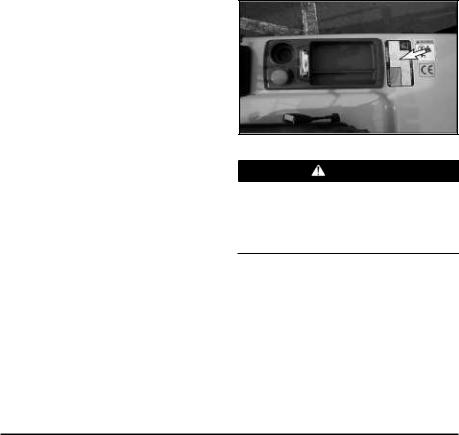
Safety
The safety rules and regulations in this section are representative of some, but not all rules and regulations noted under the Occupational Safety and Health Act (OSHA) and are paraphrased without representation that the OSHA rules and regulations have been reproduced verbatim.
Please refer to 1910. 178 in Federal Register Vol. 37, No. 202, the National Fire Protection Association No. 505 (NFPA), American National Standard, ANSI B56. 1 Safety Standard for Low lift and High Lift Trucks and subsequent revisions for a complete list of OSHA rules and regulations as to the safe operation of powered industrial lift trucks. Since regulations vary from country to country outside in U.S.A., operate this lift truck in accordance with local regulations.
DOOSAN lift trucks are manufactured according to the regulations and standards laid down in EU Machinery Directive 98/37/EC and EMC directive 89/336/EC. Please refer to the Directives 89/655/
EC and 89/391/EC and its amendments for the safe use of DOOSAN lift trucks.
The most effective method of preventing serious injury or death to the lift truck operator or others is for the lift truck operator to be familiar with the proper operation of the lift truck, to be alert and to avoid actions or conditions which can result in an accident.
Do not operate a lift truck if in need of repair, defective or in any way unsafe. Report all defects and unsafe conditions immediately. Do not attempt any adjustments or repairs unless trained and authorized to do so.
Safety Section
Warning Signs and Labels
There are several specific safety signs on your lift truck. Their exact location and description of the hazard are reviewed in this section. Please take the time to familiarize yourself with these safety signs.
Make sure that you can read all warning and instruction labels. Clean or replace these labels if you cannot read the words or see the pictures. When cleaning the labels use a cloth, water and soap. Do not use solvent, gasoline, etc.
You must replace a label if it is damaged, missing or cannot be read. If a label is on a part that is replaced, make sure a new label is installed on the replaced part. See your dealer for new labels.
Training Required To Operate or Service Warning
Located on the right side of the steering wheel.
WARNING
Improper operation or maintenance could result in injury or death. Do not operate or work on the lift truck unless you are properly trained. Read and understand the Operation and Maintenance
Manual. Additional manuals are available from DOOSAN Lift Truck dealers.
This label also provides allowable lift truck capacity information.
G |
5 |

Safety Section
General Warnings to Operator
WARNING
Only trained and authorized personnel may operate this machine. For safe operation, read and follow the operation and maintenance Manual furnished with this lift truck and observe the following warnings :
1.Before starting machine. Check all controls and warning devices for proper operation.
2.Refer to machine identification plate for allowable machine capacity. Do not overload. Operate machines equipped with attachments as partially loaded machines when not handling a load.
3.Put directional control or shift lever in neutral before "ON-OFF" switch is turned on.
4.Start, turn and brake smoothly. Slow down for turns, slippery or uneven surfaces. Extremely poor surfaces should be repaired. Avoid running over loose objects or holes in the roadway surfaces. Use extreme caution when turning on inclines.
5.Travel with load as low as possible and tilted back. If load interferes with visibility, travel with load trailing.
6.On grade operations travel with load up grade.
7.Watch out for pedestrians and obstructions. Check overhead clearances.
8.Do not permit riders on forks or machine at any time.
9.Do not allow anyone to stand or pass under the elevated portion of any machine.
10.Be sure operating surface can safely support machine.
11.Operate machine and attachments only from operator's position.
12.Do not handle unstable or loosely stacked loads.
13.Use minimum tilt when picking up or depositing a load.
14.Use extreme care when handling long, high, or wide loads.
15.Forks should be completely under load and spread apart as far as load permits.
16.Machine should be equipped with overhead guard or equivalent protection. Where load requires it, use load backrest extension. Use extreme caution if operating without these devices.
17.Parking-Lower lifting mechanism to floor. Put directional control or shift lever in neutral. Set parking/secondary brake. Turn "ON - OFF" switch off. Chock wheels if machine is on incline. Disconnect battery when storing electric machines.
18.Observe safety rules when handling fuel for engine powered machine and when changing batteries for electric machines.
19.The emergency switch uses in emergency really. When you use often emergency switch by key
switch, you can cause fatal mistake to your machine.
G
20.If user operates continuously pushing work or both brake pedal and accelerator pedal were depressed at the same time, main electric parts were able to damage.
G |
6 |
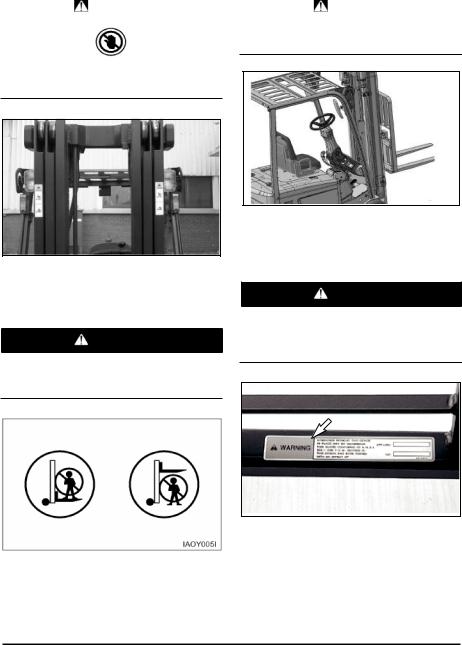
|
|
Safety Section |
Hand Placement Warning |
|
Load Backrest Must Be In Place Warning |
|
|
|
WARNING |
|
WARNING |
|
||
|
|
|
|
|
|
No hands. Do not place hands in this area. Do not touch, lean on, or reach through the mast or permit others to do so.
Operation without this device in place may be hazardous.
Located on the mast.
No Standing On Forks Warning, No
Standing Under Forks Warning
WARNING
Do not stand or ride on the forks. Do not stand or ride on a load or pallet on the forks. Do not stand or walk under the forks.
Located on the lift cylinder.
Located on the load backrest.
Overhead Guard Must Be In Place
Warning
WARNING
Operation without this device in place may be hazardous. This guard conforms to A.N.S.I.B56.1 and F.E.M. Section IV. This design has been tested with an impact of appropriate value.
IB9O004P
Located on the Overhead Guard.
G |
7 |
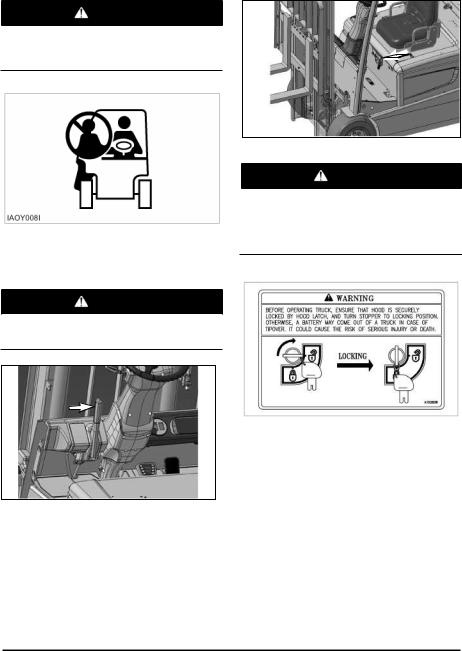
Safety Section
No Riders Warning |
Battery Restraint Warning |
WARNING
To avoid personal injury, allow no riders. A lift truck is designed for only one operator and no riders.
Located beside the operator's station.
Parking Brake Warning
WARNING
When leaving machine apply parking brake! Parking brake is not automatically applied.
G
G
G
G
G
G
G
G
Located on the top left side of the cowl.
Located on front of battery cover.
WARNING
Before operating truck, ensure that hood is securely locked by hood latch, and turn stopper to locking position. Otherwise, a battery may come out of a truck in case of tipover. It could cause the risk of serious injury or death.
G |
8 |
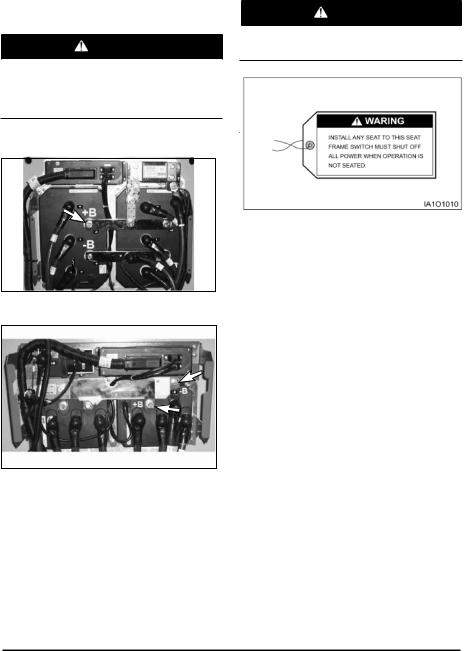
Battery Disconnect Before Servicing
Warning
AC
WARNING
Disconnect battery from truck and also discharge high voltages from capacitor banks with a 150 ohm, 25 watt Resistor before attempting to service this truck.(B+, B-)
(36V/48V)
G
G
G
G
G
G
G
G
G
G
G
G
G
G
(80V)
G
Safety Section
Seat Switch Warning
WARNING
Install any seat to this seat frame. Switch must shut off all power when operator is not seated.
G |
9 |

Safety Section
General Hazard Information
Attach a "Do Not Operate" or similar warning tag to start switch or controls before servicing or repairing the lift truck.
Do not start or service the lift truck when a "DO NOT OPERATE" or similar warning tag is attached to the start switch or controls.
Wear a hard hat, protective glasses and other protective equipment as required by job conditions.
Know the width of your attachments so proper clearance can be maintained when operating near fences, boundary obstacles, etc.
Do not wear loose clothing or jewelry that can catch on controls or other parts of the lift truck.
Keep the lift truck, especially the deck and steps, free of foreign material such as debris, oil tools and other items which are not part of the lift truck.
Secure all loose items such as lunch boxes, tools and other items which are not part of the lift truck.
Know the appropriate work-site hand signals and who gives them. Accept signals from one person only.
Always use the overhead guard. The overhead guard is intended to protect the lift truck operator from overhead obstructions and from falling objects.
A truck that is used for handing small objects or uneven loads must be fitted with a load backrest.
If the lift truck must be operated without the overhead guard in place due to low overhead clearance, use extreme care. Make sure there is no possibility of falling objects from any adjacent storage or work area. Make sure the load is stable and fully supported by the carriage and the load backrest extension (if equipped).
Do not raise loads any higher than necessary and never raise a load higher than 1830 mm (72 in) with the overhead guard removed.
Always use load backrest extension when the carriage or attachment does not fully support the load. The load backrest extension is intended to prevent the load or any part of the load from falling backwards into the operator's station.
When operating the lift truck, do not depend only on flashing lights or back-up alarm (if equipped) to warn pedestrians.
Always be aware of pedestrians and do not proceed until the pedestrians are aware of your presence and intended actions and have moved clear of the lift truck and/or load.
Do not drive lift truck up to anyone standing in front of an object.
Obey all traffic rules and warning signs.
Keep hands, feet and head inside the operator station. Do not hold onto the overhead guard while operating the lift truck. Do not climb on any part of the mast or overhead guard or permit others to do so.
Do not allow unauthorized personnel to ride on the forks or any other part of the lift truck, at any time.
When working in a building or dock, observe floor load limits and overhead clearances.
Inhaling Freon gas through a lit cigarette or other smoking method or inhaling fumes released from a flame contacting Freon can cause bodily harm or death. Do not smoke when servicing air conditioners or wherever Freon gas may be present.
Never put maintenance fluids into glass containers. Use all cleaning solutions with care.
Do not use steam, solvent, or high pressure to clean electrical components.
Report all needed repairs.
G |
10 |

Lift Chains
Inspect the part of the chain that is normally operated over the crosshead roller. When the chain bends over the roller, the movement of the parts against each other causes wear.
Inspect to be sure that chain link pins do not extend outside of the bore hole.
If any single link pin is extended beyond its connecting corresponding link, it should be suspected of being broken inside of its bore hole.
Inspect the chain anchor and the anchor links for wear.
Do not change any factory set adjustment values (including engine rpm setting) unless you have both authorization and training. Especially Safety equipment and switches may not be removed or adjusted incorrectly. Repairs, adjustments and maintenances that are not correct can make a dangerous operating condition.
For any checkup, repair, adjustments, maintenance
and all other work concerning your forklift truck, please contact your DOOSAN dealer. We would like
to draw your attention to the fact that any secondary damages due to improper handling, insufficient
maintenance, wrong repairs or the use of other than original DOOSAN spare parts waive any liability by
DOOSAN.
Safety Section
Operation Information
Mounting and Dismounting
Mount and dismount the lift truck carefully.
Clean your shoes and wipe your hands before mounting.
Use both hands face the lift truck when mounting and dismounting.
Use the handgrips for mounting and dismounting.
Do not try to climb on or off the lift truck when carrying tools or supplies.
Do not use any controls as handholds when entering or leaving the operator's station.
Never get on or off a moving lift truck. Never jump off the lift truck.
Keep hands and steering wheel free of slippery material.
Before Starting the Lift Truck
Perform a walk-around inspection daily and at the start of each shift. Refer to the topic "Walk-around Inspection" in "Every 10 Service Hours or Daily" section of this manual.
Adjust the seat so that full brake pedal travel can be obtained with the operator's back against the seat back.
Make sure the lift truck is equipped with a lighting system as required by conditions.
Make sure all hydraulic controls are in the HOLD position.
Make sure the direction control lever is in the NEUTRAL position.
Make sure the parking brake is engaged.
Make sure no one is standing and/or working on, underneath or close to the lift truck before operating the lift truck.
Operate the lift truck and controls only from the operator's station.
G |
11 |

Safety Section
Make sure the lift truck horn, lights, backup alarm (if equipped) and all other devices are working properly.
Check for proper operation of mast and attachments. Pay particular attention to unusual noises or erratic movement which might indicate a problem.
Make sure service and parking brakes, steering, and directional controls are operational.
Make sure all personnel are clear of lift truck and travel path.
Refer to the topic "Lift Truck Operation" in the "Operation Section" of this manual for specific starting instructions.
Starting the Lift Truck
Do not start the engine or move any of the controls if there is a "DO NOT OPERATE" or similar warning tag attached to the start switch or controls.
Before Operating the Lift Truck
Test brakes, steering controls, horn and other devices for proper operation. Report any faulty performance. Do not operate lift truck until repaired.
Learn how your lift truck operates. Know its safety devices. Know how the attachments work. Before moving the lift truck, look around. Start, turn and brake smoothly.
An operator must constantly observe his lift truck for proper operation.
Operating the Lift Truck
Always keep the lift truck under control.
Obey all traffic rules and warning signs.
Never leave the lift truck with the engine operating, or with the parking brake disengaged.
Operate the engine only in a well ventilated area. Lower the mast, with or without load, before turning or traveling. Tip over could result. Watch out for overhead obstructions.
Always observe floor load limits and overhead clearance.
Start, turn, and brake smoothly. Slow down for turns, grades, slippery or uneven surfaces.
Use special care when operating on grades. Do not angle across or turn on grades. Do not use a lift truck on slippery grades. Travel with forks downgrade when unloaded. Travel with load upgrade.
Do not overload, or handle offset, unstable, or loosely stacked loads. Refer to load capacity plate on the lift truck. Use extreme caution when handling suspended, long, high or wide load.
Tilt an elevated load forward only when directly over unloading area and with load as low as possible.
Do not stunt ride or indulge in horseplay.
Always look and keep a clear view of the path of travel.
Travel in reverse if load or attachment obstructs visibility. Use extreme caution if visibility is obstructed.
Stay in designated travel path, clear of dock edges, ditches, other drop-
offs and surfaces which cannot safely support the lift truck.
Slow down and use extra care through doorways, intersections and other location where visibility is reduced.
Slow down for cross aisles, turns, ramps, dips, uneven or slippery surfaces and in congested areas and avoid pedestrians, other vehicles, obstruction, pot holes and other hazards or objects in the path of travel.
G |
12 |

Always use overhead guards except where operation conditions do not permit. Do not operate lift truck in high stacking areas without overhead guards.
When stacking, watch for falling objects. Use load backrest extension and overhead guard.
Refer to the topic "Operation Techniques" in the "Operation Section" of this manual.
Loading or Unloading Trucks/Trailers
Do not operate lift trucks on trucks or trailers which are not designed or intended for that purpose. Be certain truck or trailer brakes are applied and wheel chocks in place (or be certain unit is locked to the loading dock) before entering onto trucks or trailers.
If trailer is not coupled to tractor, make sure the trailer landing gear is properly secured in place. On some trailers, extra supports may be needed to prevent upending or corner dipping.
Be certain dock plates are in good condition and properly placed and secured. Do not exceed the rated capacity of dock boards or bridge plates.
Lift Truck Parking
When leaving the operator station, park the lift truck in authorized areas only. Do not block traffic.
zPark the lift truck level, with the forks lowered and the mast tilted forward until the fork tips touch the floor.
zMove the direction control lever to NEUTRAL.
zEngage the parking brake.
zTurn the key switch off and remove the key.
zTurn the disconnect switch to OFF (if equipped).
zBlock the drive wheels when parking on an incline.
Safety Section
Maintenance Information
Perform all maintenance unless otherwise specified as follows :
zPark the lift truck in authorized areas only.
zPark the lift truck level, with the forks lowered and the mast tilted forward until the fork tips touch the floor.
zPlace the control lever in neutral.
zEngage the parking brake.
zRemove the start switch key and turn the disconnect switch OFF (if equipped).
zBlock the drive wheels when parking on an incline.
Pressure Air
Pressure air can cause personal injury. When using pressure air for cleaning, wear a protective face shield, protective clothing and protective shoes.
The maximum air pressure must be below 205 kPa (30 psi) for cleaning purposes.
Fluid Penetration
Always use a board or cardboard when checking for a leak. Escaping fluid under pressure, even a pinhole size leak, can penetrate body tissue, causing serious injury, and possible death. If fluid is injected into your skin, it must be treated by a doctor familiar with this type of injury immediately.
Crushing or Cutting Prevention
Support equipment and attachments properly when working beneath them. Do not depend on hydraulic cylinders to hold it up. Any attachment can fall if a control is moved, or if a hydraulic line breaks.
Never attempt adjustments while the lift truck is moving or the engine is running unless otherwise specified.
Where there are attachment linkages, the clearance in the linkage area will increase or decrease with movement of the attachment.
Stay clear of all rotating and moving parts.
G |
13 |

Safety Section
Keep objects away from moving fan blades. They will throw or cut any object or tool that falls or is pushed into them.
Do not use a kinked or frayed wire rope cable. Wear gloves when handling the wire rope cable.
Retainer pins, when struck with force, can fly out and injure nearby persons. Make sure the area is clear of people when driving retainer pins.
Wear protective glasses when striking a retainer pin to avoid injury to your eyes.
Chips or other debris can fly off objects when struck. Make sure no one can be injured by flying debris before striking any object.
Falling Objects Protective Structure (FOPS)
This is an attached guard located above the operator's compartment and secured to the lift truck.
To avoid possible weakening of the Falling Objects Protective Structure (FOPS), consult a DOOSAN dealer before altering, by adding weight to, welding on, or cutting or drilling holes into the structure.
The overhead guard is not intended to protect against every possible impact. The overhead guard may not protect against some objects penetrating into the operator's station from the sides or ends of the lift truck.
The lift truck is equipped with an overhead guard and FOPS as standard. If there is a possibility of overhead objects falling through the guard, the guard must be equipped with smaller holes or a Plexiglas cover.
Any altering done that is not specifically authorized by DOOSAN invalidates DOOSAN’s FOPS
certification. The protection offered by this FOPS will be impaired if it has been subjected to structural damage. Structural damage can be caused by an overturn accident, by falling objects, etc.
Do not mount any item such as fire extinguishers, first aid kits and lights by welding brackets to or drilling holes in any FOPS structure. See your DOOSAN dealer for mounting guidelines.
Burn Prevention
Oils
Hot oil and components can cause personal injury. Do not allow hot oil or components to contact the skin.
At operation temperature, the hydraulic tank is hot and can be under pressure.
Remove the hydraulic tank filter cap only after the engine has been stopped and the filter cap is cool enough to remove with your bare hand.
Remove the hydraulic tank filter cap slowly to relieve pressure.
Relieve all pressure in air, oil fuel or cooling systems before any lines, fittings or related items are disconnected or removed.
Batteries
Only trained and designated personnel should inspect, recharge or exchange batteries.
Always wear protective glasses when working with batteries.
Service, exchange and handle batteries only in authorized areas when proper safety and ventilation facilities are provided.
Do not smoke, or expose battery to sparks or flame when checking, charging or servicing battery. Keep chains and metallic tools away from top of battery.
Batteries give off flammable fumes which can explode.
Highly explosive gases are especially hazardous toward the end of the charging period as the battery approaches a full charge condition.
Electrolyte is an acid and can cause personal injury if it contacts skin or eyes.
Service batteries in accordance with battery manufacture instructions.
Refer to the topic "Batteries" in the "Maintenance Section" of this manual.
G |
14 |
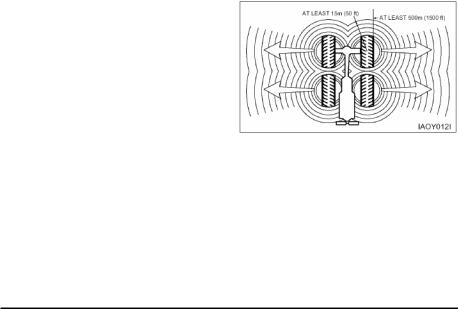
Fire or Explosion Prevention
All fuels, most lubricants and some coolant mixtures are flammable.
Do not smoke in areas where batteries are charged, or where flammable materials are stored.
Clean and tighten all electrical connections. Check daily for loose or frayed electrical wires. Have all loose or frayed electrical wires tightened, repaired or replaced before operating the lift truck.
Keep all fuels and lubricants stored in properly marked containers and away from all unauthorized persons.
Store all oily rags or other flammable material in a protective container, in a safe place.
Do not weld or flame cut on pipes or tubes that contain flammable fluids. Clean them thoroughly with nonflammable solvent before welding or flame cutting on them.
Remove all flammable materials such as fuel, oil and other debris before they accumulate on the lift truck.
Do not expose the lift truck to flames, burning brush, etc., if at all possible.
Do not operate in areas where explosive gases exist or are suspected.
Fire Extinguisher
Have a fire extinguisher-type BC and 1.5KG minimum capacity-on rear overhead guard leg with latch and know how to use it. Inspect and have it serviced as recommended on its instruction plate.
Lines, Tubes and Hoses
Do not bend or strike high pressure lines. Do not install bent or damaged lines, tubes or hoses.
Repair any loose or damaged fuel and oil lines, tubes and hoses. Leaks can cause fires. Contact your DOOSAN dealer for repair or replacement.
Check lines, tubes and hoses carefully. Do not use your bare hand to check for leaks. Use a board or cardboard to check for leaks. See Fluid Penetration in the Safety Section for more details. Tighten all connections to the recommended torque. Replace if any of the following conditions are found.
zEnd fittings damaged or leaking.
Safety Section
zOuter covering chafed or cut and wire reinforcing exposed.
zOuter covering ballooning locally.
zEvidence of kinking or crushing of the flexible part of hose.
zArmoring embedded in the outer cover.
zEnd fittings displaced.
Make sure that all clamps, guards and heat shields are installed correctly to prevent vibration, rubbing against other parts, and excessive heat during operation.
Tire Information
Explosions of air-inflated tires have resulted from heat-induced gas combustion inside the tires. The heat, generated by welding or heating rim components, external fire, or excessive use of brakes can cause gaseous combustion.
A tire explosion is much more violent than a blowout. The explosion can propel the tire, rim and axle components as far as 500 m (1500 ft) or more from the lift truck. Both the force of the explosion and the flying debris can cause personal injury or death, and property damage.
Do not approach a warm tire closer than the outside of the area represented by the shaded area in the above drawing.
Dry nitrogen (N2) gas is recommended for inflation of tires. If the tires were originally inflated with air, nitrogen is still preferred for adjusting the pressure. Nitrogen mixes properly with air.
G |
15 |
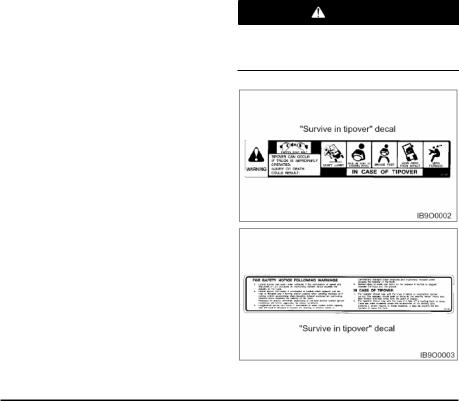
Safety Section
Nitrogen inflated tires reduce the potential of a tire explosion, because nitrogen does not support combustion. Also, nitrogen helps prevent oxidation and the resulting deterioration of rubber and corrosion of rim components.
Proper nitrogen inflation equipment and training in its use are necessary to avoid over inflation. A tire blowout or rim failure can result from improper or misused equipment.
Stand behind the tread and use a self-attaching chuck when inflation a tire.
Servicing, changing tires and rims can be dangerous and should be done only by trained personnel using proper tools and procedures. If correct procedures are not followed while servicing tires and rims, the assemblies could burst with explosive force and cause serious personal injury or death. Follow carefully the specific information provided by your tire or rim servicing personnel or dealer.
Operator Restraint System (If
Equipped)
Warning Signs and Labels
Your DOOSAN lift truck has the following tipover warning decals.
Make sure that you can read all safety signs. Clean or replace these if you cannot read the words or see the pictures. When cleaning the labels use a cloth, water and soap. Do not use solvent, gasoline, etc. You must replace a label if it is damaged, missing or cannot be read. If a label is on a part that is replaced,
make sure a new label is installed on the replaced part. See you DOOSAN Lift Truck dealer for new
labels.
The most effective method of preventing serious injury or death to yourself or others is to familiarize yourself with the proper operation of the lift truck, to be alert, and to avoid actions or conditions which can result in an accident.
WARNING
Tipover can occur if the truck is improperly operated. In the event of tipover, injury or death could result.
G |
16 |
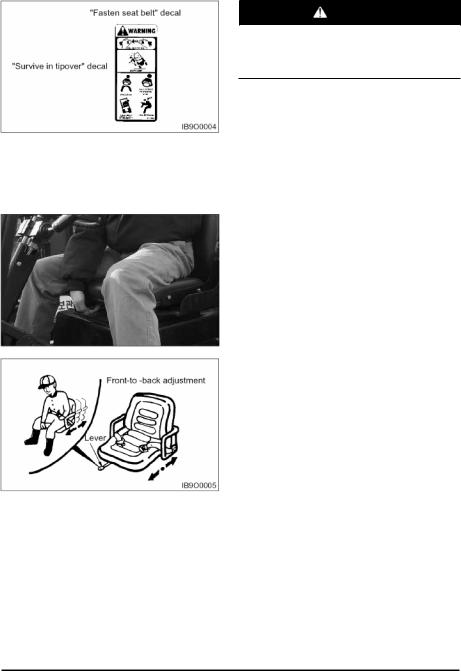
Safety Section
WARNING
Do NOT place your hand or fingers under the seat. Injury may occur as the seat moves up and down.
The "Survive in tipover" warning is located on the overhead guard. It shows the proper use of the operator restraint system.
Seat Adjustment
Move the lever, slide the seat to the desired position, and release the lever.
Adjust the seat before operating the lift truck. After adjusting, set the seat to make sure it is properly locked. DO NOT adjust the seat while the truck is in motion.
G |
17 |
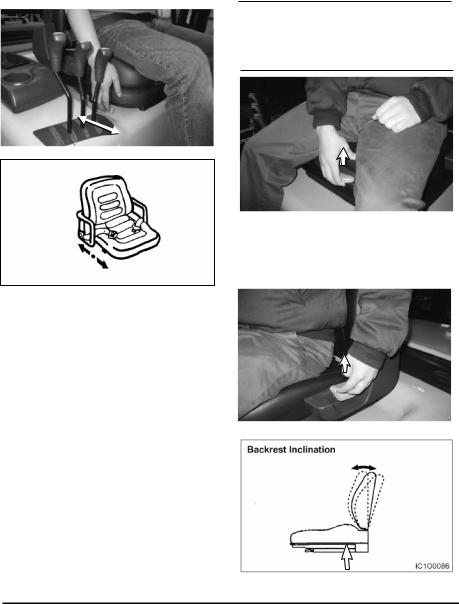
Safety Section
If Optional Suspension Seat Equipped
Forward and Backward Adujstment
G
The seat can be adjusted by pushing the lever on the right side of seat.
G
Forward and Backward
Adujstment
Adjust the seat before operating the lift truck. After adjusting, set the seat to make sure it is properly locked. DO NOT adjust the seat while the truck is in motion.
Weight adjustment
Pull the weight adjustment lever upwards and move right or left side.
Adjust to driver’s weight in 7 steps (50 ~ 110 kg)
G
G
NOTICE
Do not place your hand or fingers under the seat. Injury may occur as the seat moves up and down.
Backrest Inclination
The backrest angle can be adjusted by using the lever on the left side of seat.
G |
18 |
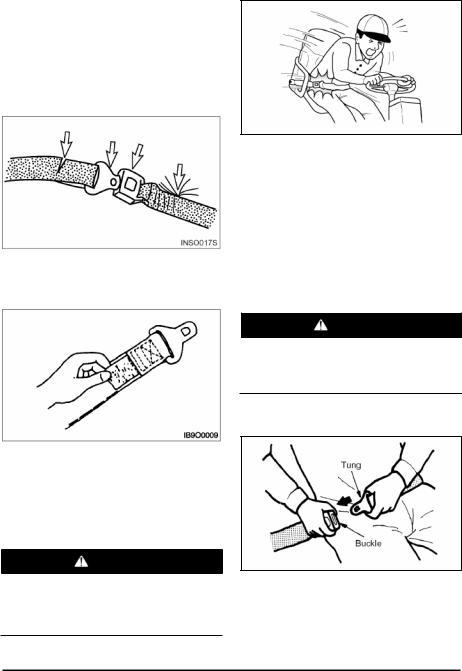
Seat Belt
The Operator Restraint System, Prevents the operator from jumping from the operator's compartment in the event of forward or side tipover. The system is designed to keep the operator on the seat and in the operator's compartment in the event of tipover.
Inspection
1.If the seat belt is torn, if pulling motion is interrupted during extension of the belt, or if the belt cannot be inserted into the buckle properly, replace the seat belt assembly.
Safety Section
G
3.In the event of tipover, the seat and restraint system should be inspected for damage and replaced, if necessary.
NOTE: Operator restraints shall be examined at the regular truck service intervals. It is recommended that they be replaced if any of the following conditions are found:
G
zCut or frayed strap
zWorn or damaged hardware including anchor points
zBuckle or retractor malfunction
zLoose stitching
WARNING
The seat belt may cause the operator to bend at the waist. If you are pregnant or have suffered from some abdominal disease, consult a doctor before you use the seat belt.
Fasten the Seat Belt
2.Belt Maintenance – Every 500 service hours. Check that the belt fastening works properly and that winding device is free from run lock when jerked. Check that the belt is suitably fastened to the seat. Check that the seat is correctly secured to the hood and the chassis. On visual inspection, fastenings must be intact, otherwise, contact the safety manager.
WARNING
Your DOOSAN truck comes equipped with a DOOSAN operator restraint system. Should it become necessary to replace the seat for any reason, it should only be replaced with another DOOSAN operator restraint system.
G
1.Grip the plate (connector) of the belt and pull the belt from the retractor. Then insert the plate into the slot of the buckle until a snap is heard. Pull on the belt to confirm it is latched.
2.Make sure the belt is not twisted.
G |
19 |
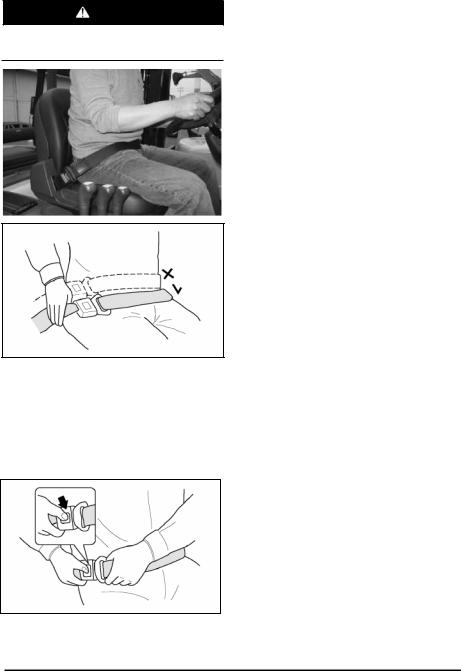
Safety Section
WARNING
If you fasten the belt across your abdomen, the belt may injure your abdomen in an accident.
3.Be sure to fasten the belt across your hips, not across your abdomen.
NOTE: The belt is designed to automatically adjust to your size and movement. A quick pull on the belt will confirm that the automatic adjuster will hold the belt position in the event of an accident.
Release the Seat Belt
G
Push the button of the buckle to release the belt. The belt will automatically retract when released.
Hold the plate of the belt and allow the belt to slowly retract.
G |
20 |
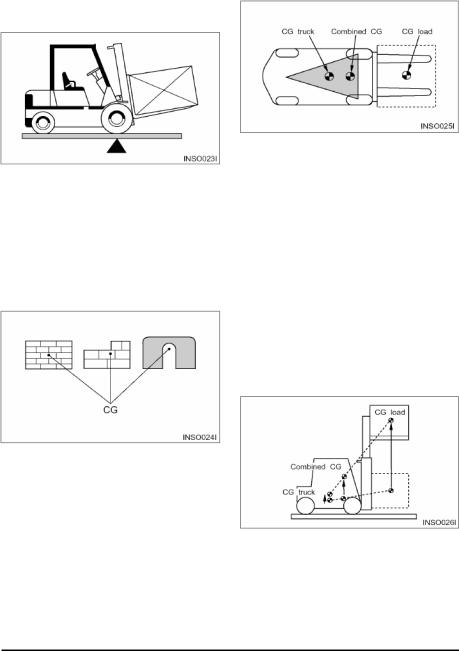
Avoiding Lift Truck Tipover
Lift Truck Stability
Counterbalanced lift truck design is based on the balance of two weights on opposite sides of a fulcrum (the front axle). The load on the forks must be balanced by the weight of the lift truck.
The location of the center of gravity of both the truck and the load is also a factor. This basic principle is used for picking up a load. The ability of the lift truck to handle a load is discussed in terms of center of gravity and both forward and sideways stability.
Center of Gravity (CG)
The point within an object, at which the whole weight of the object may be regarded as being concentrated, is called the center of gravity or CG. If the object is uniform, its geometric center will coincide with its CG. If it is not uniform, the CG could be at a point outside of the object. When the lift truck picks up a load, the truck and load have a new combined CG.
Safety Section
Stability and Center of Gravity
The stability of the lift truck is determined by the location of its CG; or, if the truck is loaded, the combined CG of the truck and load. The lift truck has moving parts and, therefore, has a CG that moves. The CG moves forward or backward as the mast is tilted forward or backward. The CG moves up or down as the mast moves up or down. The CG and, therefore, the stability of the loaded lift truck, are affected by a number of factors such as:
zthe size, weight, shape and position of the load
zthe height to which the load is lifted
zthe amount of forward or backward tilt
ztire pressure
zdynamic forces created when the lift truck is accelerated, braked or turned
zcondition and grade of surfaces on which the lift truck is operated
These same factors are also important for unloaded lift trucks. They tip over sideways easier than a loaded lift truck carrying its load in the lowered position.
G |
21 |

Safety Section
Lift Truck Stability Base
For the lift truck to be stable (not tip over forward or to the side), the CG must stay within the area of the lift truck stability base – a triangular area between the front wheels and the pivot of the steer wheels. If the CG moves forward of the front axle, the lift truck will tip forward. If the CG moves outside of the line on either side of the stability base, the lift truck will tip to the side.
WARNING
Dynamic forces (braking, acceleration, turning) also affect stability and can produce tipover even when the CG is within the stability triangle.
Capacity Load (Weight and Load Center)
The capacity load of the lift truck is shown on the capacity/nameplate riveted to the truck. It is determined by the weight and load center. The load center is determined by the location of the CG of the load.
The load center shown on the nameplate is the horizontal distance from the front face of the forks, or the load face of an attachment, to the CG of the load. The location of the CG in the vertical direction is the same as the horizontal dimension.
Remember that, unless otherwise indicated, the capacity load shown on the nameplate is for a standard lift truck with standard backrest, forks and mast, and having no special-purpose attachment. In addition, the capacity load assumes that the load center is no further from the top of the forks than it is from the face of the backrest. If these conditions do not exist, the operator may have to reduce the safe operating load because the truck stability may be reduced. The lift truck should not be operated if its capacity/nameplate does not indicate capacity load.
NOTE: If the load is not uniform, the heaviest portion should be placed closer to the backrest and centered on the forks.
NOTICE
1.Capacity/Nameplates originally attached to forklifts sold by DOOSAN shall not be removed, altered or replaced without DOOSAN’s approval.
2.DOOSAN assumes no responsibility for lift trucks placed in service without a valid DOOSAN Nameplate.
3.If necessary to change your specification, contact your DOOSAN lift truck dealer.
G |
22 |
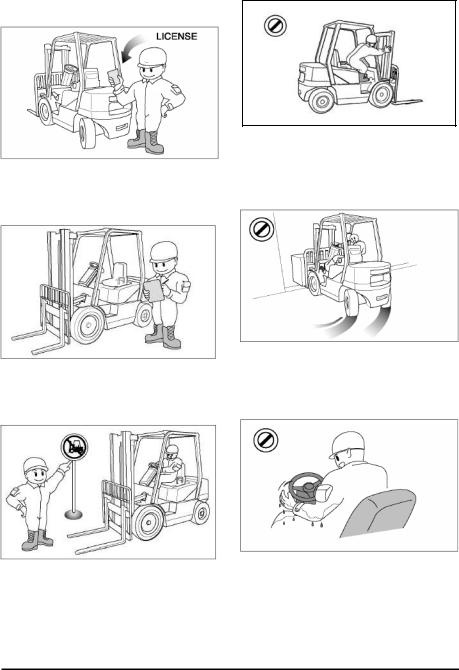
Safety Rules
Only properly trained and authorized personnel should operate forklift trucks. Wear a hard hat and safety shoes when operating a lift truck. Do not wear loose clothing.
Inspect and check the condition of your forklift truck using the operator's check list before starting work. Immediately report to your supervisor any obvious defects or required repairs.
Do not operate your truck in unauthorized areas. Know your forklift truck and think safety.
Do not compromise safety.
Follow all safety rules and read all warning signs.
Safety Section
Do not operate a lift truck unless you are in the operator’s seat. Keep hands and feet inside the operator’s compartment. Do not put any part of the body outside of the operator’s compartment. Never put any part of body into the mast structure or between the mast and the truck
Do not start, stop, turn or change direction suddenly or at high speed. Sudden movement can cause the lift truck to tip over. Slow the speed of your truck and use the horn near corners, exits, entrances, and near people.
Never operate a lift truck with wet hands or shoes. Never hold any controls with grease on your hands. Your hands or feet will slide off of the controls and cause an accident.
G |
23 |
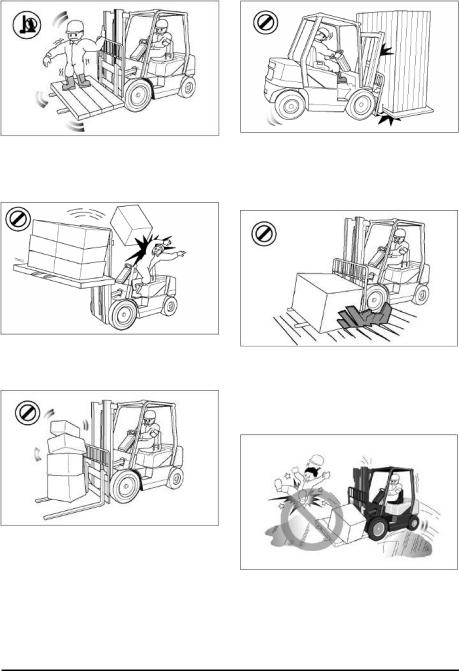
Safety Section
Do not raise anyone on the forks of your lift truck unless using an approved safety cage. Do not let other people ride on the truck. Lift trucks are designed to carry loads, not people.
Do not operate your truck without the load backrest extension and overhead guard. Keep the load against the backrest with the mast tilted backward.
Do not lift or move loads that are not safe. Do not pick up an off center load. Such a load increases the possibility of a tipover to the side. Make sure loads are correctly stacked and positioned across both forks. Always use the proper size pallet. Position the forks as wide as possible under the load. Position loads evenly on the forks for proper balance. Do not lift a load with one fork.
Do not overload. Always handle loads within the rated capacity shown on the capacity plate.
Do not add extra counterweight to the truck. An overload can cause the truck to roll over and cause injury to personnel and damage to the lift truck.
Do not drive on soft ground.
Observe all signs, especially those on maximum permitted floor loadings, elevator capacities and clearance heights.
Handle loads carefully and check them closely for stability and balance.
Do not drive on slippery surfaces.
Sand, gravel, ice or mud can cause a tipover. If unavoidable, slow down.
G |
24 |
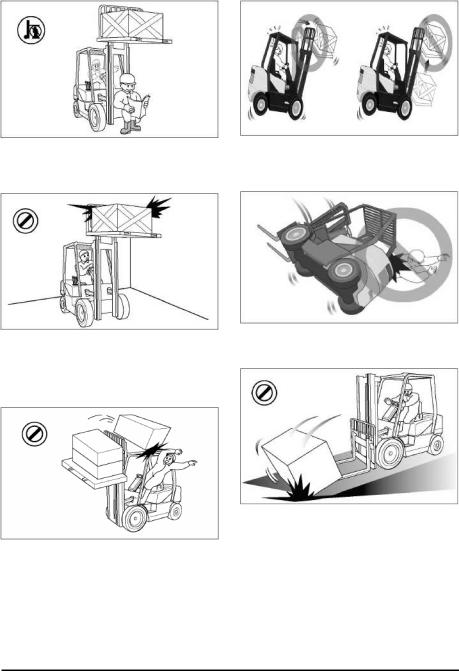
Safety Section
Do not permit anyone to stand or walk under the load or lifting mechanism. The load can fall and cause injury or death to anyone standing below.
Look out for overhead obstructions when raising or stacking loads. Do not travel with a raised load. Do not travel with the mast raised. The lift truck can roll over and cause injury or death to you or other personnel.
Do not move loose loads that are higher than the load backrest.
Be alert for falling loads when stacking.
Travel with the load tilted back and the forks as low as possible.
This will increase stability to the truck and load and permit better visibility for you.
Do not elevate the load with the mast tilted forward. Do not tilt the elevated loads forwards.
This will cause the lift truck to tip over forward.
Do not jump off if your truck starts to tip over. Stay in your seat to survive.
Go up ramps in forward direction and down ramps in reverse direction when moving loads.
Never elevate a load with the forklift truck on an incline.
Go straight off and straight down. Use an assistant when going up or down a ramp with a bulky load.
G |
25 |
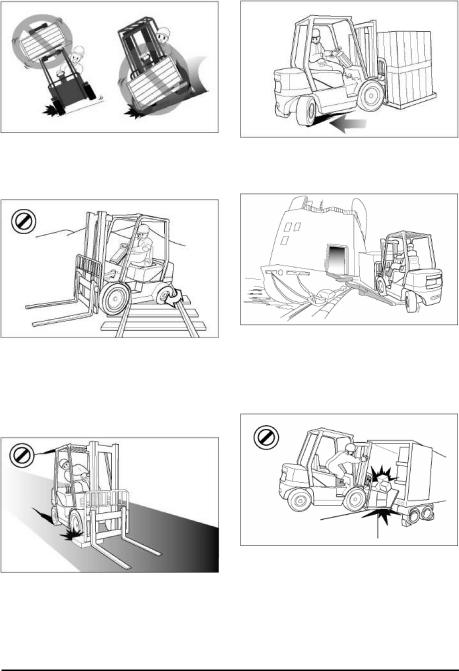
Safety Section
Do not stack or turn on ramps.
Do not attempt to pick-up or deposit a load unless the lift truck is level. Do not turn on or drive across an incline.
Do not go over rough terrain. If unavoidable, slow down.
Cross railroad tracks slowly and diagonally whenever possible. A railroad crossing can give a loaded forklift truck a real jolt. For smoother crossing, cross the railroad diagonally so one wheel crosses at a time.
Avoid running over loose objects. Look in the direction of travel. Look out for other persons or obstructions in your path of travel. An operator must be in full control of his lift truck at all times.
Do not drive in forward direction when loads restrict your visibility. Operate your lift truck in reverse to improve visibility except when moving up a ramp.
Be careful when operating a lift truck near the edge of a loading dock or ramp. Maintain a safe distance from the edge of docks, ramps and platforms. Always watch tail swing.
The truck can fall over the edge and cause injury or death.
Do not operate on bridge plates unless they can support the weight of the truck and load. Make sure that they are correctly positioned. Put blocks on the vehicle you enter to keep it from moving.
G |
26 |
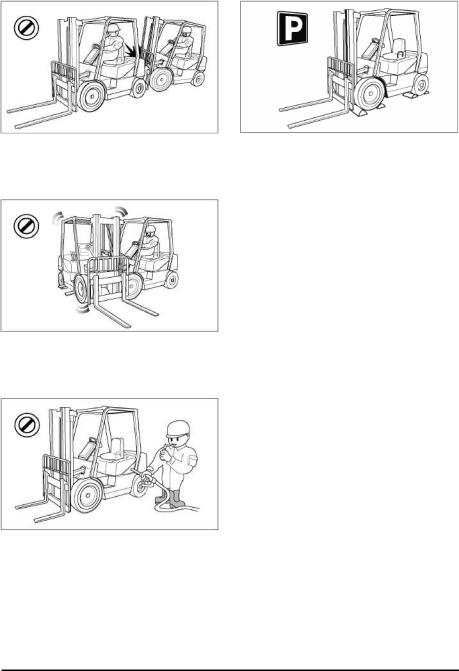
Do not operate your truck close to another truck. Always keep a safe distance from other trucks and make sure there is enough distance to stop safely. Never overtake other vehicles.
Do not use your lift truck to push or tow another truck.
Do not let another push or tow your truck.
If a truck will not move, call a service technician.
Forklift trucks may only be refueled at specially reserved locations. Switch off the engine when refueling.
Smoking and handling of naked flames during refueling are strictly prohibited. This prohibition also applies during the changing of the LPG (liquefied propane gas) tank.
Mop up spilt fuel and do not forget to close the fuel tank before restarting the engine.
Safety Section
Park your lift truck in authorized areas only. Fully lower the forks to the floor, put direction lever in NEUTRAL position, engage the parking brake, and turn the key to the OFF position. Remove the key and put blocks behind the wheels to prevent the truck from rolling. Shut off your forklift truck when leaving it unattended.
Check the condition of your forklift truck after the day's work.
G |
27 |
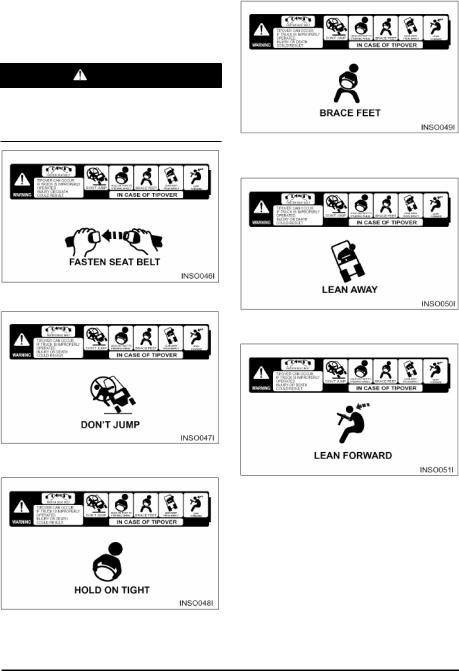
Safety Section
How to Survive in a Tipover (If Operator Restraint System Equipped)
WARNING
In the event of a tip over, the risk of serious injury or death will be reduced if the operator is using the operator restraint system and follows the instructions provided.
Always use operator restraint system.
Don’t jump.
Brace your feet and keep them within the operator's compartment.
Lean away from the direction of fall.
Lean forward
Hold on tight.
G |
28 |
